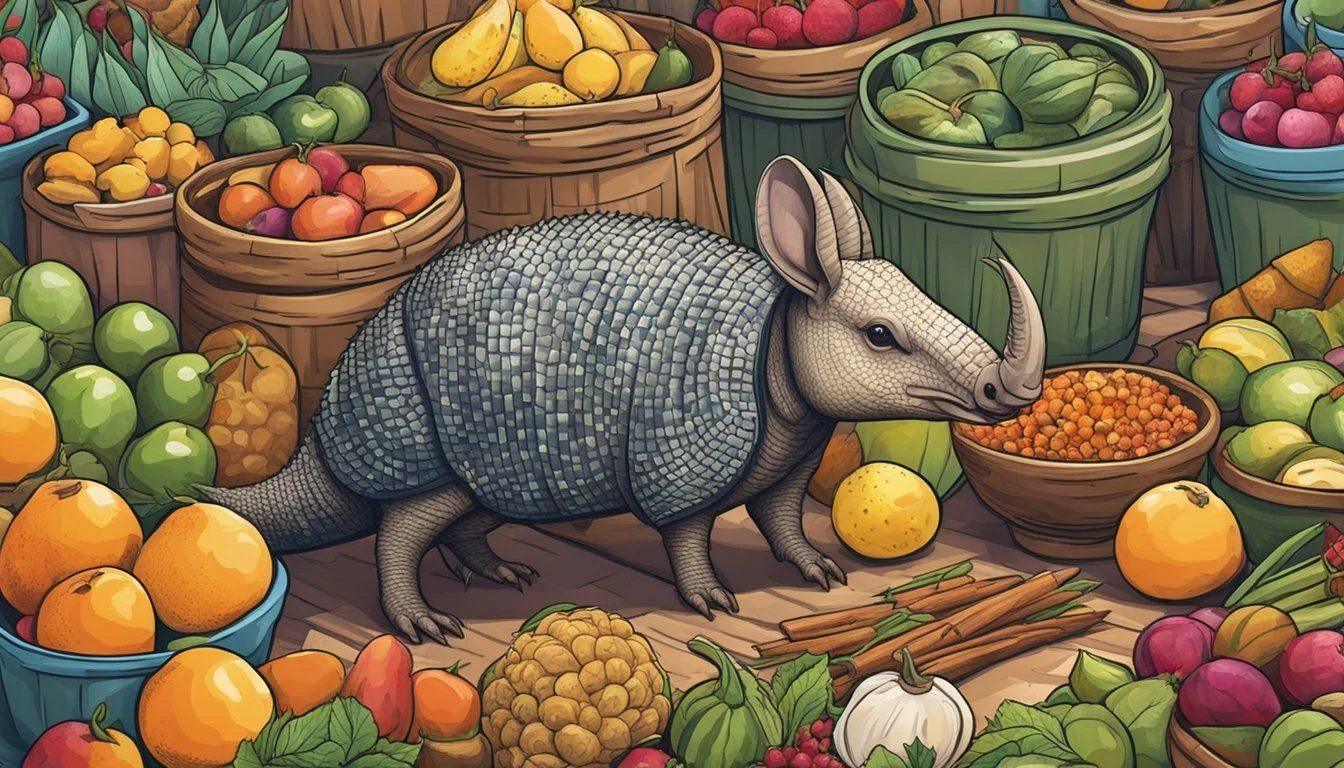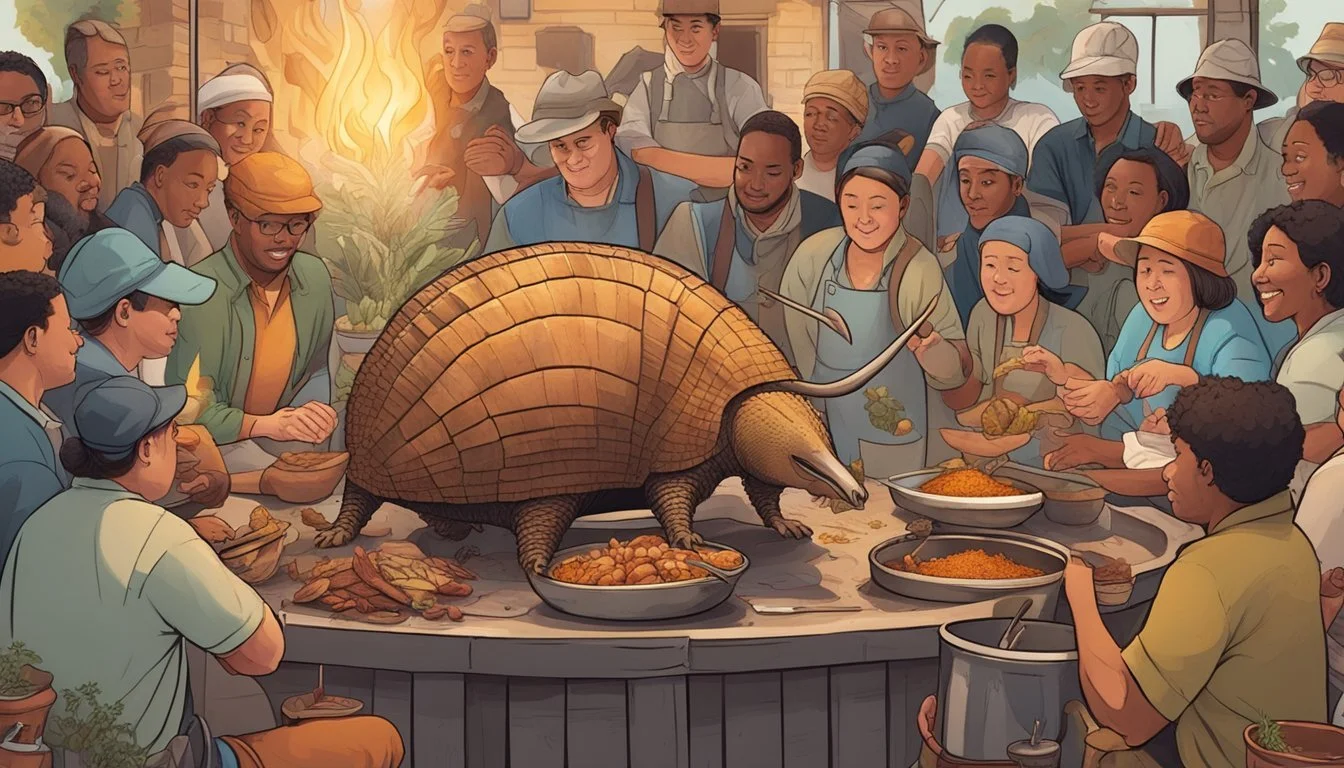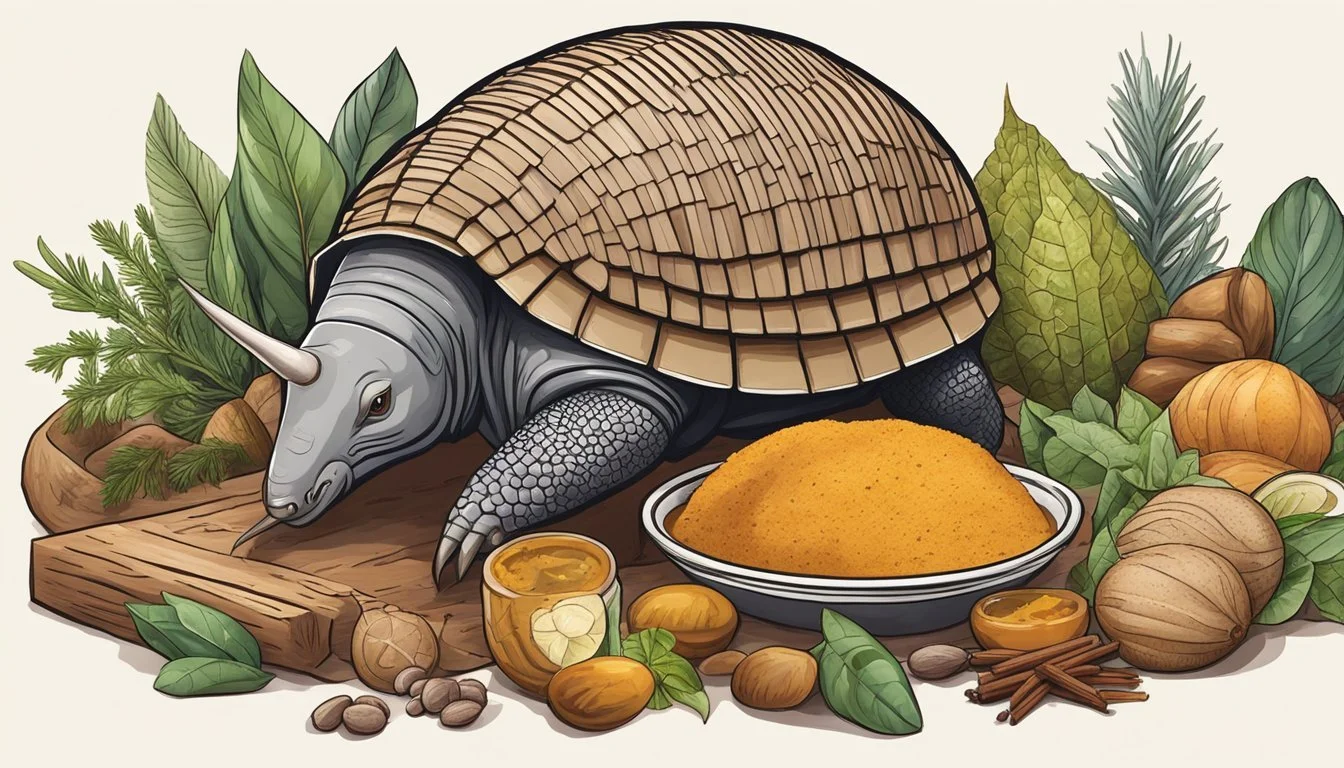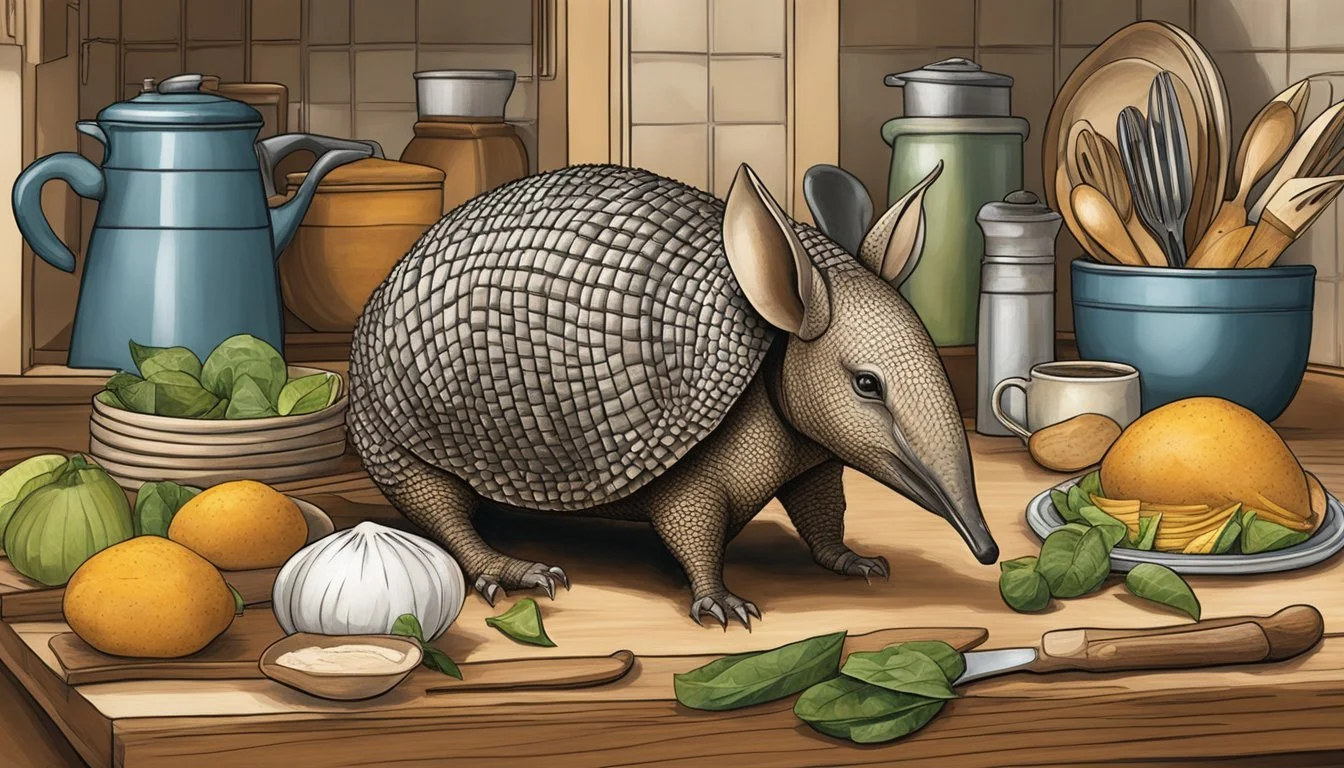Armadillo Meat
A Deep Dive into Its Role in Southern U.S. and Latin American Dishes
The armadillo, an animal with a distinctive armored shell, has made its way into various aspects of culture in the Southern U.S. and throughout Latin America. In some regions, it's viewed as much more than a peculiar mammal; it has been integrated into local cuisine with a history of consumption that provokes both curiosity and controversy. While its meat is not commonplace on dining tables, in certain cultures within the Southern U.S. and Latin America, armadillo dishes are part of traditional culinary practices.
Consuming armadillo meat raises a complex blend of health, ethical, and environmental considerations. Public health officials have expressed concerns due to the link between armadillo meat and the transmission of leprosy to humans—a connection corroborated by scientific research identifying the same strain of M. leprae in both armadillos and afflicted humans in the Southern U.S. Despite potential health risks, the practice of eating armadillo persists, reflecting a culinary tradition that, for some, supersedes such concerns.
In the culinary landscape, the armadillo is sometimes seen as a game meat that offers a unique flavor to those willing to try it. Its preparation and consumption are deeply rooted in the food traditions of some Southern and Latin American communities, where it is often cooked in stews or grilled. These regions display a rich tapestry of gastronomy where armadillo meat is part of a heritage that stretches back through generations, reflecting a reliance on local fauna for sustenance.
Armadillo Biology and Habitat
Understanding armadillo biology and habitat is essential for comprehending their role in various regional cuisines. This section breaks down the species diversity, remarkable physical adaptations, unique reproductive strategies, and the creatures' diets and habitats that contribute to their survival and culinary use.
Species Diversity and Geographic Range
Armadillos comprise approximately 21 species, primarily native to Latin America, with a significant presence in South America and Mexico. The nine-banded armadillo, however, has broadened its range significantly, now being found as far north as Maryland and West Virginia in the United States. This range extends across several southern U.S. states, including Texas, Louisiana, Florida, Mississippi, North Carolina, Georgia, Tennessee, and into Virginia.
Physical Characteristics and Armor
Armadillos are known for their distinctive armor, which is, in fact, a protective shell consisting of bony plates called the carapace. Their body is also shielded, including the head and tail. The nine-banded armadillo typically features a brown or greyish leathery shell and can grow to about 30 inches in length, including the tail.
Reproductive Behaviour: Identical Quadruplets
One of the most unusual reproductive features of the nine-banded armadillo is its ability to give birth to identical quadruplets in every litter. This consistent quadruplet birth ensures a stable population growth and aids their expansion across diverse regions.
Diet and Burrowing Habits
Armadillos are primarily insectivores, with a diet consisting of insects, grubs, and other small invertebrates. Their strong legs and sharp claws are perfectly adapted for digging extensive burrow systems in search of food and to create shelters. The type of soil, ranging from soft and sandy to somewhat harder clay, in the southern U.S. states, provides an ideal environment for armadillo burrowing activity.
Health Aspects of Armadillos
When considering the consumption of armadillo meat, it's essential to be aware of the health implications, particularly their potential to transmit diseases like leprosy.
Potential for Disease Transmission
Armadillos are known to carry various pathogens that can potentially infect humans. This risk is particularly noted when these animals are hunted, handled, or consumed as meat. Scientists have identified armadillos as a natural reservoir for the bacteria Mycobacterium leprae, which causes Hansen's disease or leprosy. Leprosy is a concern given its ability to cause long-term nerve damage in the extremities if left untreated.
Armadillos and Leprosy Concerns
The connection between armadillos and leprosy has been substantiated through genetic testing, which has confirmed a match between the Mycobacterium leprae strains in both armadillos and humans in the southern United States. The majority of cases in the U.S. appear concentrated in states where armadillos are prevalent. While the overall risk of transmission to humans is low, those who handle or consume armadillo meat are at greater risk. Leprosy is treatable with antibiotics, but early detection and treatment are crucial to prevent serious health outcomes.
Culinary History of Armadillo Meat
Armadillo meat, once a necessary source of nourishment, has evolved into a component of regional cuisines with lingering controversy regarding its health implications and cultural importance.
Armadillo in Traditional and Modern Cuisines
Armadillo meat has been part of various cultural diets for centuries, with its roots deeply embedded in Latin American culinary traditions before spreading to the Southern United States. In many areas, it was historically consumed due to its abundance and cost-effectiveness, earning the nickname "Hoover hog" during the Great Depression in America as it became a staple for impoverished families. Today, the meat is occasionally featured in specialty dishes. It is notably used in chili recipes and can be found in the context of American cuisine, specifically within the regional cuisines of Texas where Tex-Mex flavors reign.
Traditional Recipes:
Latin American dishes
Hoover hog during economic hardships
Modern Inclusion:
Specialty American and Tex-Mex cuisines
Throughout the evolution of its use, armadillo meat has transitioned from a survival food to a more unique choice within modern menus, often served as a reminder of history or as an exotic delicacy.
Cultural Significance and Controversy
Culturally, armadillo meat has a dual perception; some communities honor it as a traditional element of their heritage, while others view its consumption with skepticism due to health risks. In regions where armadillos are plentiful, such as Texas and parts of Latin America, the meat is intertwined with local traditions that have been passed down through generations, cementing its place in the food narrative. On the other hand, this culinary tradition faces criticism due to potential health risks, including the transmission of Hansen's disease, also known as leprosy.
Heritage:
Integral to certain regional and local traditions
Health Concerns:
Risk of disease transmission such as Hansen's disease
The preparation and consumption of armadillo meat remain a topic of controversy, juxtaposing cultural significance with contemporary health awareness.
Preparation and Cooking Techniques
When it comes to armadillo meat, preparation and cooking techniques are crucial to ensure safety and maximize flavor. These methods have been developed and refined over centuries, particularly in regions where the armadillo is a traditional dish.
Cleaning and Butchering
To prepare an armadillo for cooking, one must begin with the cleaning and butchering process. It's imperative that the butchering is done meticulously to avoid contact with the animal's blood and internal organs, which could harbor diseases like leprosy. The cleaning process involves:
Dressing: Removal of the armadillo's hard shell and skin.
Butchering: The meat is then separated into cuts, typically eschewing the internal organs.
Protective gloves should be worn throughout this process, and the meat should be thoroughly washed before moving on to cooking.
Cooking Methods and Popular Recipes
Armadillo meat is typically tough and requires slow cooking methods to tenderize. Here are some techniques and recipes utilized in its preparation:
Oven Roasting: Seasoned with salt, pepper, and other spices, the meat can be wrapped in foil and slow-cooked in an oven. This method is conducive to retaining moisture and enhancing flavor.
Armadillo Chili: A popular dish in the Southern U.S., it's a hearty stew that combines armadillo meat with traditional chili ingredients like beans, tomatoes, and a rich mix of spices. Armadillo meat can be a substitute for beef or pork in chili recipes.
Regardless of the recipe, cooking armadillo meat thoroughly is essential. Using a meat thermometer ensures that the internal temperature reaches a safe level, reducing the risk of any food-borne illness.
Serving and Pairing
When serving armadillo meat, the focus is on complementing its unique flavor with suitable sides and beverages. The richness of the meat pairs well with an array of traditional side dishes and thoughtful beverage selections.
Side Dishes and Accompaniments
Armadillo meat, known for its dense texture, is traditionally accompanied by a variety of side dishes that balance its rich profile:
Vegetables: A medley of roasted vegetables, including carrots, squash, and zucchini, can provide a delightful contrast.
Rice: White or yellow rice, often seasoned with herbs, serves as a neutral base that absorbs the armadillo's robust juices.
Corn: Cornbread or grilled corn on the cob complements the meat's savory notes.
Avocados: Fresh avocado slices or guacamole add a creamy texture that smooths out the meal.
Salsa: A tangy tomato salsa can enhance the meat with a burst of acidity and spice.
Tomatoes: Freshly diced or stewed tomatoes offer a juiciness that plays off the heft of the armadillo meat.
Wine and Beverage Pairings
Choosing the right beverage to pair with armadillo can elevate the dining experience significantly:
Red Wine: A full-bodied red wine, such as a Malbec or Shiraz, has the tannic structure to stand up to the meat's boldness.
Beer: A crisp lager can cleanse the palate between bites, while a darker ale could match the richness of the meat.
Non-Alcoholic Options: For those preferring non-alcoholic beverages, a rich, tart cherry or pomegranate juice can provide a similar balance to wine.
Conservation and Ethical Considerations
As armadillo meat becomes a culinary interest in certain regions of the Southern U.S. and Latin America, it's crucial to balance the demand with conservation efforts and acknowledge the ethical concerns surrounding armadillo hunting.
Impact on Armadillo Populations
Armadillos, part of the superorder Xenarthra, are a group of armored mammals notable for their bony plates. However, their distinctive characteristics have not shielded them from the negative impacts of hunting and habitat destruction. Conservation programs suggest that armadillo populations can face significant decline if hunting is not managed responsibly. For example, increased hunting pressure can shift the species' conservation status, pushing them closer towards the list of threatened species. Population monitoring, therefore, plays a critical role in gauging the sustainability of hunting practices.
Legal and Ethical Aspects of Hunting
Hunting armadillos, like any wildlife, is governed by wildlife laws which vary greatly by region. These laws are designed to protect both the armadillo populations and the ecosystems they inhabit. In many areas, specific hunting seasons and bag limits are established to prevent overhunting. The ethical aspects of hunting these creatures are also a point of contention. Concerns range from the potential suffering of the animals to the implications on local ecosystems and the natural balance of predators and prey. It is crucial for hunters to adhere to legal guidelines and consider the broader ethical implications of their actions on nature and conservation.
Understanding these perspectives can inform decision-making and foster practices that not only appreciate the culinary value of armadillos but also respect their role in our world's biodiversity.
Armadillo in Popular Culture
The armadillo, a distinctive creature with a leathery armor shell, has woven itself into the fabric of popular culture, particularly in the Southern U.S and Latin American regions, turning up in literature, folklore, symbolism, and various forms of entertainment.
Literature, Folklore, and Symbolism
The armadillo holds notable significance in Southern U.S. and Latin American literature and folklore. In Native American culture, it is often seen as a symbol of protection due to its hard outer shell, which serves as a physical barrier against predators. The creature is also associated with attributes of resilience and adaptability, a fitting representation given its survival in diverse environments from the dry regions of the Appalachian to the more humid climates of the Southern U.S. In some tales and parables, armadillos are depicted as clever beings that overcome obstacles, much like the "speed bump" they sometimes become on highways, teaching a lesson about vigilance.
In Latin American stories, the armadillo's burrowing nature is symbolic of one's connection to the earth and the cycles of life and nature. Its presence in literature is often a nod to its ancient roots and ability to persist through the ages.
Armadillos in Arts and Entertainment
In arts and entertainment, the armadillo's unique appearance and characteristics have inspired various creative expressions. They have been featured in songs, cartoons, and even as mascots, reflecting the cultural identity of the regions they inhabit. Southern U.S. music, for example, occasionally references armadillos to evoke the local wildlife and connect with the regional audience.
Visual arts in both the Southern U.S. and Latin America sometimes incorporate armadillo motifs; their image is used in everything from traditional designs to modern logos, symbolizing resilience and the spirit of the South. In contemporary media, characters based on armadillos are designed to capture attention due to their unusual and striking form, and they often embody the characteristics associated with the actual animal, like protection and sturdiness.









